
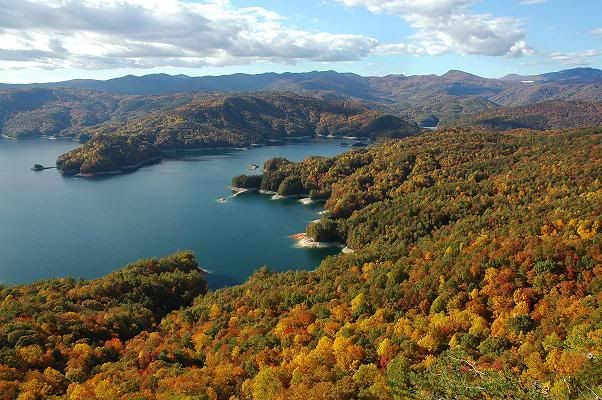
Jumping Off Rock is regarded by many as the most breathtaking spot in South Carolina. From this incomparable vista one can view the magnificent landscape that testifies to the dynamic geologic history of this area. (Photo by Greg Lucas of SC DNR)
Geology of the Jocassee Gorges, Mountain Bridge Area, and Northwestern South Carolina in Greenville, Oconee, and Pickens Counties, South Carolina
(selected text and pictures used by permission)
Open-File Poster OFP-03-09 is available from SC Department of Natural Resources and SC Geological Survey.
Geology mapped: John M. Garihan, C. W. Clendenin, and W. A. Ranson
Map Compilation: Jennifer L. Krauser
Layout and Graphics: Erin E. Koch
July 27, 2009
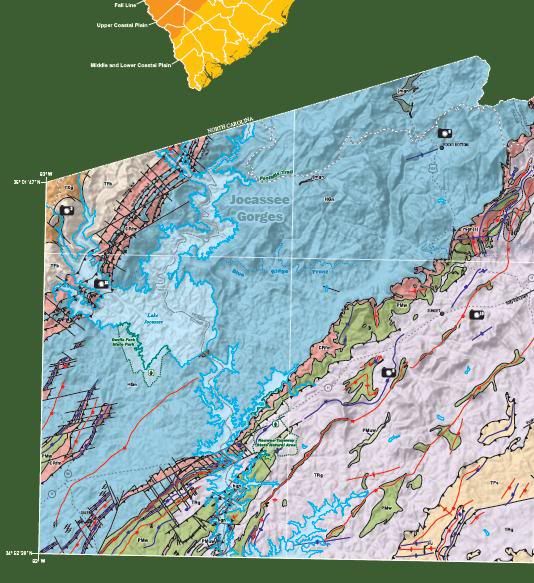
At Jumping Off Rock you are positioned literally at the edge of the Southern Blue Ridge Escarpment. From this vantage point the panoramic view encompasses the central part of the Jocassee Thrust Sheet (depicted in blue on the map above). A thrust sheet is a large body or package of rock separated from other geologic formations by slip or thrust faults. Thrust nappe is another term for this “river of rock.” The Jocassee Thrust Sheet is an excellent example of a generally well-defined, intact thrust sheet. It is comprised predominantly of Henderson Gneiss, is bounded on the northwest and southeast by discernible faults, and is being down-cut by a spectacular river system.
Here in the Inner Piedmont tectonic province, three allochthonous (non-native or “moved”) rock packages are vertically “stacked like overlapping cards in a deck”. They are tilted to the southeast, from the lowest (Jocassee Thrust Sheet, {blue}), to the higher (Walhalla Nappe {pink and green}), to the highest (Six Mile Thrust Sheet {grey}). “In general, the different thrust sheets were pushed to the northwest and southwest during multiple stages” of the formation of mountains in the Paleozoic era (roughly 545 million to 200 million years ago).
The Eastatoee thrust fault (or “bounding fault”) separates the Jocassee Thrust Sheet from the overlying Walhalla Nappe (as pictured below).
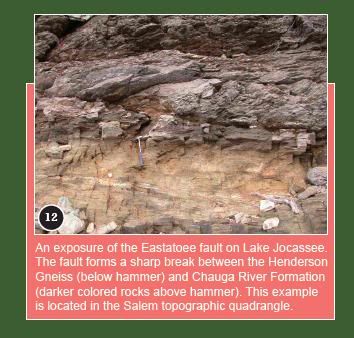
Most of the rocks in the Jocassee area were formed during the Paleozoic era. “Prior to being metamorphosed, the rocks were originally of sedimentary and igneous origin. Metamorphism occurred when the rocks were subjected to elevated temperatures and pressures in the earth’s crust. During the Paleozoic era, the rocks were repeatedly metamorphosed, folded, or thrust under ductile conditions by orogenic compressional events” (i.e., the formation of mountains).
The Jocassee Thrust Sheet is composed mainly of Henderson Gneiss, “a medium-gray, biotite granite augen gneiss….Feldspar makes ‘warts’ on the surface of the rock because it is more resistant to weathering.”
Composition of Henderson Gneiss, by Jack Garihan and Charlotte Marek.
Logging Requirements
To log this Earthcache, please visit the site, complete the following activities, and email your answers to the CO:
1. Locate the memorial monument to Jim “Doc” Timmerman. In your opinion, is it composed of Henderson Gneiss? Why or why not? (Timmerman, who died in 2005, protected thousands of acres of land for conservation during his tenure as director of the S.C. Department of Natural Resources (DNR) and was one of the key figures in the state's acquisition of Jocassee Gorges.)
2. Examine the large boulders that are arranged along the edge of the viewing site. Compare them to the monument. Can you determine if they are autochthonous (native, indigenous) or allochthonous (moved, relocated) rocks? How many of these boulders guard the precipice of Jumping Off Rock?
3. Based on your general knowledge and your observations from this vantage point, what qualities distinguish a gorge from a valley?
Bonus Question: The memorial monument reads: "Dr. James A. Timmerman Jr. was director of the S.C. Department of Natural Resources from 1974 to 1997. Known as 'Doc' by friends and colleagues, he was instrumental in South Carolina's purchase and protection of more than 50 square miles of land surrounded by Lake Jocassee. By resolution of the South Carolina Senate, the area was named 'The Jim Timmerman Natural Resources Area at Jocassee Gorges' on Dec. 7, 2000. Doc's lifelong devotion to conservation is remembered with swift mountain streams, rare plant habitats and the abundance of wildlife that combine to give Jocassee Gorges its unique character and scenic beauty. His legacy for future generations is the preservation and enhanced appreciation of our natural heritage. Doc often remarked, 'God visits the _______, but He lives in the __________.'" (Fill in the blanks; both answers have geologic significance)
Please use extreme caution when exploring the Jumping Off Rock area!
GEOLOGY
The Jocassee Gorges, situated in the Blue Ridge province, comprise a series of intermontane valleys flanked by steep northeast-trending mountain ridges. South Carolina's portion of the Blue Ridge is 90 miles long and 25 to 30 miles wide, spanning Oconee County and extending eastward into Greenville County. Topographically, the Chattooga Ridge is a narrow transition about 6 miles wide that separates the Blue Ridge province's rugged southeast flank from the rolling hills of the Piedmont (from the French word meaning "foot of the mountain").
Geologically, the Jocassee Gorges erode two tectonic provinces in South Carolina: the Blue Ridge and the Inner Piedmont (including the Chauga belt, Walhalla nappe, and Six Mile nappe). The Brevard fault zone, a regional northeast-striking structure, separates the two tectonic provinces and can be traced 300 km along the eastern edge of the Appalachian Mountains from Alabama to Virginia. Many of the area's northeast-trending mountain ridges are also structurally oriented features, related to the Blue Ridge-Inner Piedmont thrusting that resulted from at least three (continent-to-continent) collisions. Rocks of the Jocassee Gorges are metamorphosed marine and volcanic rock, known as schist and gneiss (pronounced nice) and are part of the southern Appalachian metamorphic core. These rocks are folded, twisted, and squeezed together and provide stark evidence of the area's 1.1 billion years of geologic history.
The end result of the erosion is magnificent vistas like Jumping Off Rock and Sassafras Mountain and gorges harboring waterfalls and cascades such as Laurel Fork Falls, Whitewater Falls, and Eastatoee Gorge. The geology combined with mild temperatures and the highest average annual rainfall in the eastern United States supports a unique diversity of plant and animal life and an ecosystem for rare flora and fauna.
From Jocassee Gorges: A Partnership in Conservation.
General Information
We are grateful to Greg Lucas and his colleagues at the SC Department of Natural Resources for permission to place this Earthcache at the Jumping Off Rock vista. Special thanks go to Jocassee Gorges Project Manager Mark Hall as well. Please respect all posted signs and employ “Leave No Trace” practices.
The view from Jumping Off Rock takes in parts of the only temperate rainforest in the eastern US (receiving 100 inches or more of rain per year). Because of the soil composition, climate, abundant rainfall, and remoteness of the area, several communities of rare plants and animals thrive in this seemingly difficult environment.
All the Jocassee Gorges main access roads are now open and will remain open year-round. Horsepasture Road from US 178 to the popular overlook and Camp Adger Road from US 178 to the Horse Mountain gate will be open for licensed vehicles. For safety, no ATV use will be allowed during the summer months.
Jocassee Gorges roads to Jumping Off Rock to remain open year-round
IMPORTANT NOTE: In the last few years a pair of peregrine falcons has nested in the cliffs adjacent to Jumping Off Rock. In fact, they took over the original JOR, which was closed to the public in 2008. Accessing the nesting area of the peregrines is now strictly prohibited!
From the new Jumping Off Rock vista (built by SC DNR in 2009) you can watch the falcons perform their incredible aerial acrobatics. These masters of the sky are regarded as the fastest birds in flight.
Flying with the peregrine falcons
Watching the peregrine falcons from the new “Jumping Off Rock”
“Jocassee Peregrine Falcons Migrate to Safer Home”
Peregrine falcons at the new Jocassee overlook
Directions
Access to Jumping Off Rock is via the scenic and historic Horsepasture Road. From US 178, turn onto Horsepasture Road at Eastatoee Gap (JOR is 9.8 miles ahead). From SC 11, take Roy Jones Road to Cleo Chapman Road, and then catch the Cane Creek access (JOR is 9.3 miles ahead).
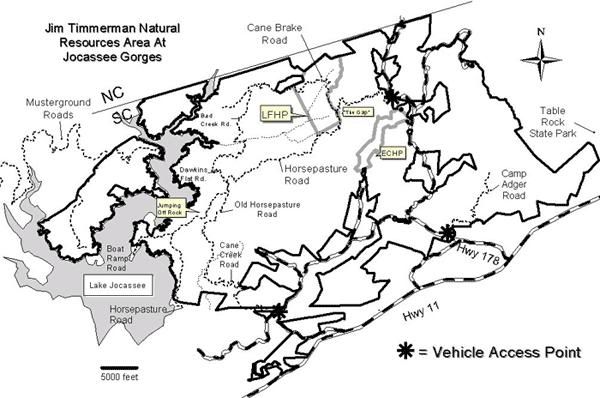
Map of Jocassee Gorges
Peregrine falcons at the new Jocassee overlook
“Jocassee Adventure” by Talley V. Kayser
“Field Trip: Drive to Jumping Off Rock” by Greg Lucas
According to noted SC DNR conservation educator and recreation specialist, Greg Lucas, “The green (DNR) gates are open for vehicles during the fall and winter, September 15 through January 15, and again in the spring, March 20 through May 10. One of the reasons for the summer closure of roads to vehicles is to give wildlife populations, such as black bears and migratory songbirds, a break during summer breeding season. Of course, you can make this trip any time of year on foot, on mountain bike or on horseback. For stunning views all the way up the mountain, choose a date in winter or early spring when the leaves are off the trees.”
Don’t forget to stop by the nearby Laurel Fork Heritage Preserve!
The name Jocassee in Cherokee means "Place of the Lost One."
Geology of the Jocassee Gorges, Mountain Bridge Area, and Northwestern South Carolina in Greenville, Oconee, and Pickens Counties, South Carolina
(selected)
“The southern face of the Blue Ridge is a 1,500-2,000 foot mountain wall or escarpment with its base at an elevation of about 1,400 feet. This face is known as the Blue Ridge Front. The top of the escarpment serves as a drainage divide between rivers flowing southeast to the Atlantic Ocean or west to the Gulf of Mexico. Slow, modern uplift of this landscape and vigorous downcutting by the creeks and rivers has produced the area’s spectacular mountain scenery. In terms of geology, rock exposures are considered to be excellent by Piedmont standards because erosion along streams has incised the clay soils and soft weathered rock exposing Bedrock….
“The stacking of Paleozoic thrust sheets is similar to the stacking of overlapping cards in a deck. In the Mountain Bridge area, the lowest thrust sheet lies to the northwest, interestingly where the topography is rugged, and the higher ones lie to the southeast, where topography is more subdued. All thrust sheets are gently tilted to the southeast. Grain-sized reduced gneiss with abundant quartz and feldspar is the rock type typically found in the footwall immediately below each major thrust.
“Regional relations show that the Six Mile thrust sheet, with the Seneca fault at its base, overlies the Walhalla thrust sheet. Extensive faulting and erosion of the Six Mile thrust sheet have disrupted its original lateral continuity. Now the rocks of the Six Mile (Tallulah Falls Formation (TFs) and Poor Mountain Formation (PMs)) form many isolated areas (klippen). The Walhalla thrust sheet contains the Table Rock Gneiss (TRg), the Poor Mountain Formation (PMw, PMuw), and the Chauga River Formation (CRfm). The Eastatoee fault at the base of the Walhalla thrust sheets separates those rocks from the underlying Jocassee thrust sheet. Henderson Gneiss (Hgn) is the dominant rock unit in that thrust sheet. In general, the different thrust sheets were pushed to the northwest and southwest during multiple stages of Paleozoic orogenesis.
“The northeast-trending Brevard zone is a major zone of southern Appalachian faulting, which complexly interleaves rocks of the Jocassee and Walhalla thrust sheets. This structure has a long-lived history related to the geologic history of the region. The Rosman fault is the northwest edge of the Brevard zone. Northwest of the Rosman fault zone, Tallulah Falls Formation (TFb) rocks are faulted over Precambrian Toxaway Gneiss (TXg) in the Blue Ridge.”
Map and comments by John M. Garihan, C. W. Clendenin, and W. A. Ranson. Open-File Poster OFP-03-09 is available from SC Department of Natural Resources and SC Geological Survey.
Dr. Jack Garihan on “The Eastatoee Fault”
Dr. Jack Garihan on geologic mapping of the western Inner Piedmont
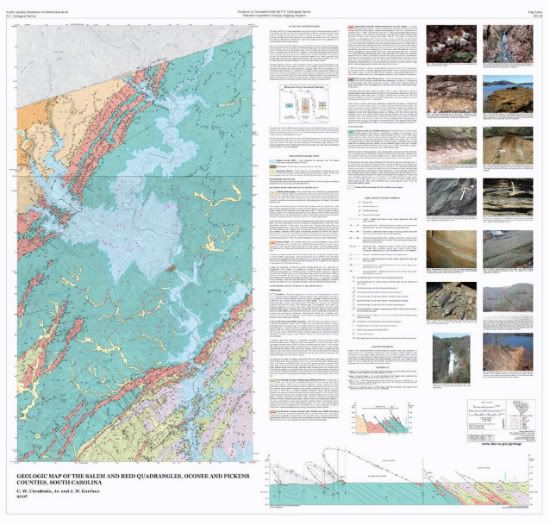
Search for geologic maps from the SC Geological Survey and the SC Department of Natural Resources.
TOP, LOF (Take Only Pictures, Leave Only Footprints)
Congrats to FTF: Fox Neumann and team!